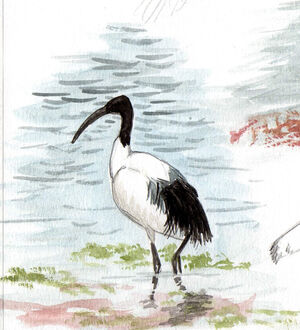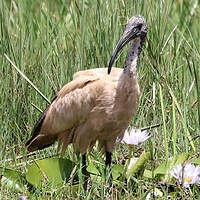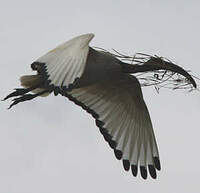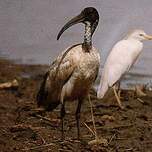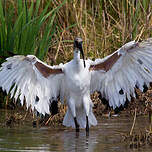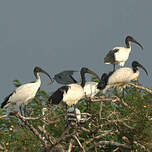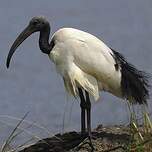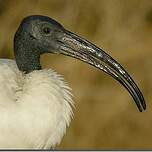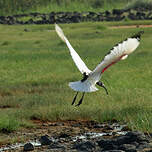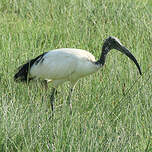African Sacred Ibis
Threskiornis aethiopicus - Ibis sacré
Identification
The African Sacred Ibis is a medium sized bird with a robust appearance. The body plumage is white while the head and neck are bare and black (the black colour is that of the skin). The tips of the wings and the underside of the back are also black. The distinctive beak is thick and curved. The sexes are similar although some authors report that the female's beak is smaller than the male's. The juveniles are easily distinguishable: they have heads and necks covered in feathers. These feathers are gradually lost between the ages of two and three. In flight, the underside of the wings is white with a brown band on the lower covers. The tip of the remiges is black.
Subspecific information monotypic species
Foreign names
- Ibis sacré,
- Ibis sagrado,
- íbis-sagrado-africano,
- Pharaonenibis,
- szent íbisz,
- Heilige Ibis,
- Ibis sacro,
- helig ibis,
- Helligibis,
- ibis posvätný,
- ibis posvátný,
- Hellig Ibis,
- pyhäiibis,
- Skoorsteenveër,
- ibis sagrat africà,
- Nílaríbis,
- ibis czczony,
- svētais ibiss,
- sveti ibis,
- Священный ибис,
- アフリカクロトキ,
- 非洲白鹮,
- helig ibis,
- 埃及聖鹮〔非洲白鹮〕,
Voice song and call
Habitat
The African Sacred Ibis reproduces today in almost all of Sub-Saharan Africa, in western Madagascar, the island of Aldabra and in southeastern Iraq, in the region of Amara.
The Ibis mainly inhabit open spaces, especially wetlands. The main types of environment used by the African Sacred Ibis mainly concern agricultural areas, wetlands, and food waste dump sites. The analysis of the distribution of this species in its natural environment in South Africa shows that the African Sacred Ibis depends mainly on prairies and grasslands at more than 80%, the rest consisting mainly of freshwater habitats, in particular shallow swamps, but also intertidal zones in estuaries. It has adapted to a wide variety of artificial habitats such as farm reservoirs, sewers, slurry reservoirs and ploughed fields. In France, on the Atlantic coast, its habitat is not much different. Here, the ibis frequent moist meadows with an intermittent presence of livestock, municipal waste dumps as well as pre-marshes or flooded reed beds.
Behaviour character trait
African Sacred Ibis gather in overnight roosts which may contain hundreds of birds. These roosts are often polyspecific.
They are located on islands in rivers or close to the coast, generally in trees. They sometimes settle in villages. The roosting sites often change, only a few sites being used throughout the year. Depending on the species, ibis are migratory or sedentary but, in many cases, they are nomadic. The erratic behaviour of birds in this family is higher in subtropical and temperate zones than in tropical areas. In France, the species does not exempt from the rule. In the three departments where they are relatively numerous (Morbihan, Loire-Atlantique, Vendée), African Sacred Ibis show great mobility while remaining confined to wet areas close to the coast and estuaries.Flight
Dietfeeding habits
African Sacred Ibises search for their prey by sight, spearing insects and other animals from the surface of the water or from dry land, or probing in mud or soft terrain with their strong, curved bills.
They feed primarily in groups, often in the company of other species such as storks, White Spoonbills, and Black-crowned Night Herons, which they can follow to snatch insects which have been disturbed. African Sacred Ibises primarily eat grasshoppers, crickets, and aquatic beetles. They also catch earthworms, molluscs, crustaceans, fish, amphibians, lizards. Predation of White Pelican and Nile Crocodile eggs, Cape Cormorant chicks and domesticated chickens have all been reported, as well as raiding of the nests of Gulls and Terns in France. The remainder of their menu consists of carrion, refuse and also seeds.Reproduction nesting
In South Africa, the breeding season coincides with the rainy season. Although they usually nest in monospecific colonies, they sometimes reproduce in mixed colonies with storks, herons, spoonbills, egrets and cormorants.
In this latter case, there does not seem to be competition between species that nest in a close space, however the nests of ibis are close in compact groups and separated from other categories of birds. The breeding sites are reused year after year and the nests, made mostly of branches, are placed close to one another. The female lays two to four eggs whose average incubation period is 28 days. The chicks leave the nest between 14 and 21 days and leave the colony after forty days. Breeding success varies greatly among colonies but is generally less than one chick per couple. African Sacred Ibis can undertake a second clutch if the first fails.In France, where it has been observed, breeding takes place from April to June, with an average of 2.85 eggs per nest. About 50% of the eggs hatch and the number of fledglings corresponds approximately to 25% of the eggs laid. In natural habitat in the West of France, African Sacred Ibis show great adaptability and use a great variety of habitats for the colonies: cypress plantations on islets, alder in the middle of vast reed beds, debris of trees stranded on sandy islets and even mainland in a semi-urban environment.
Threats - protection
IUCN conservation status
concern
in the Wild
threatened
evaluated
Uncommon. Species of tropical and southern Africa. African Sacred Ibis used to nest in Egypt. The feral French population is from Brittany. It counted more than 300 individuals at the beginning of the 90s. The introduction of this African species into an animal park is an aesthetic decision. As this ibis is a formidable predator, this introduction now poses real problems in France.
Sources of information
- IOC World Bird List (v14.2), Gill, F and D Donsker (Eds). 2024-04-18.
Other sources of interest
 Specification sheet created on
28/10/2023 by Alexandre Knochel with help of Daniel Le-Dantec and Georges Olioso
Specification sheet created on
28/10/2023 by Alexandre Knochel with help of Daniel Le-Dantec and Georges OliosoTranslation by AI Oiseaux.net
© 1996-2025 Oiseaux.net
- Accipitriformes
- Aegotheliformes
- Anseriformes
- Apodiformes
- Apterygiformes
- Bucerotiformes
- Caprimulgiformes
- Cariamiformes
- Casuariiformes
- Charadriiformes
- Ciconiiformes
- Coliiformes
- Columbiformes
- Coraciiformes
- Cuculiformes
- Eurypygiformes
- Falconiformes
- Galliformes
- Gaviiformes
- Gruiformes
- Leptosomiformes
- Mesitornithiformes
- Musophagiformes
- Nyctibiiformes
- Opisthocomiformes
- Otidiformes
- Passeriformes
- Pelecaniformes
- Phaethontiformes
- Phoenicopteriformes
- Piciformes
- Podargiformes
- Podicipediformes
- Procellariiformes
- Psittaciformes
- Pterocliformes
- Rheiformes
- Sphenisciformes
- Steatornithiformes
- Strigiformes
- Struthioniformes
- Suliformes
- Tinamiformes
- Trogoniformes

